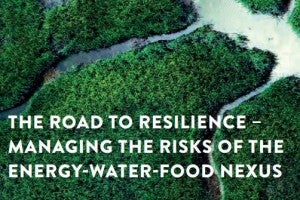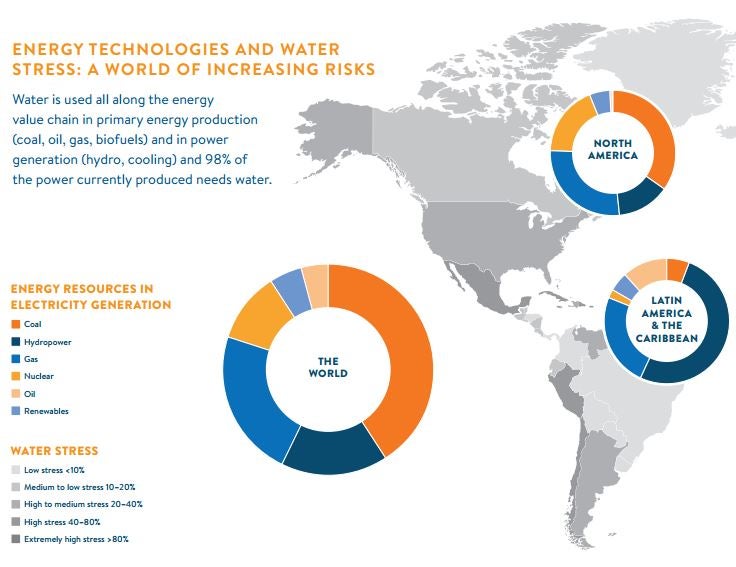Holistic Energy-Water Planning: Hedging Your Bets in a Water-Stressed World
 You probably have some sort of insurance – for your healthcare, car, house, or apartment. Acting on climate change is also like insurance. It is all about managing the risks.
You probably have some sort of insurance – for your healthcare, car, house, or apartment. Acting on climate change is also like insurance. It is all about managing the risks.
We can’t know for certain what the future brings, but recent research predicts a 40 percent shortfall of available water across the globe by 2030. In the face of this prediction, a new report from the World Energy Council, “The Road to Resilience – Managing the Risks of the Energy-Water-Food Nexus” helps lay some groundwork to ensure we plan for the climate risks that will affect our most essential resources.
I have talked about the reliance of energy on water and water on energy (the energy-water nexus), and touched on their connection to food. But let me make that linkage clearer: 70 percent of available global freshwater is used by the agricultural sector, and energy is the second-largest freshwater user globally after agriculture (although this varies from country to country and region to region). Relatedly, about 15 percent of total U.S. energy demand is for the food sector (this includes both agriculture and processing), and roughly 13 percent of U.S. energy use is for water-related purposes.
The bottom line is: Each sector relies upon and influences the other two. Moreover, water stress or scarcity has a huge impact on both our energy and food. This report focuses on how the energy sector can better manage impacts on land and water, suggesting the industry would be wise to take out a little insurance to help bolster resilience and protect itself. Let’s break down the report’s recommendations.
[Tweet “Holistic energy-water planning: Hedging your bets in a water-stressed world”]
Guidelines for creating a water-smart energy future
Because water and energy are so closely connected, vulnerabilities in one amplify the vulnerabilities of the other, compounding risk. Viewing energy through a water lens can help address critical concerns like electric reliability and resilience. Here are a few ways to get there:
- Project developers need to be able to better understand the water footprint of energy technology choices
Some energy sources use considerably less water than others – coal and nuclear top the list of thirsty energy, while energy efficiency, solar PV, and wind need negligible amounts of water. But many people are unaware of this critical factor. Taking into consideration the water requirements of energy choices could help ensure the development of projects that alleviate water stress. For example, having clear water-use data may mean electricity planners could prioritize the deployment of those sources with lower water intensity during times of drought – powering up natural gas instead of coal, perhaps, or increasing the amount of solar PV or wind in the energy balance.
- Risk assessments should reflect a comprehensive understanding of long-term system risks
It is irresponsible to plan future energy needs without careful consideration and incorporation of appropriate climate and hydrological scenarios. If full environmental modeling is not done to ensure resilience and reliability can be met with future water scenarios, investors in energy projects should rightfully be concerned. For example, if you’re planning to build a fossil fuel-fired or nuclear power plant without considering the increased water stress from climate change, the water may not be available in 15 years to cool the plant down, making these risky investments.
- Water scarcity has to be taken into account and, where possible, priced appropriately
An accurate price should include the true cost of water in relation to the energy sector. Water pricing is a highly sensitive issue, but when talking about the energy sector, just looking at the price power producers pay for the water they use – versus the water they withdraw – is not a reflection of the value. For example, although in general the amount of water consumed by an electric generating facility is much less than the water it withdraws, the water withdrawn (but not consumed) may not be in optimal condition (e.g., it may be hotter than it was when it was withdrawn). Furthermore, while the water is withdrawn it is not available for other local uses. But the price of water does not reflect these consequences. The true cost of water would include societal impacts and weighing current needs with future availability, based on climate models.
- Transparent and predictable regulatory and legal frameworks are needed
Currently water and energy are in two different silos when it comes to regulation and legal frameworks: different authorities, different budget streams, different professionals. A more comprehensive and collaborative approach could enable a more predictable and streamlined policy framework that reveals existing inefficiencies and undiscovered opportunities for efficiency.
- Measures to minimize finance cost and stabilize returns can be taken
Because of the disaggregated nature of the water sector, there are currently no comprehensive, robust financial tools to completely assess risk. One of the examples the report uses: Some parts of the financial services and insurance industries already offer instruments that consider electric price volatility, some reliability issues, and weather-related impacts. These financial products could be applied across the energy sector to hedge against risks such as water scarcity.
Because of the disaggregated nature of the water sector, there are currently no comprehensive, robust financial tools to completely assess risk.
Additionally, investors want to have confidence in the projects they invest in. Environmental Defense Fund has been instrumental in developing the Investor Confidence Project energy efficiency protocols, which help instill confidence that commercial building energy efficiency upgrades will produce the energy savings promised. In trying to establish similar protocols for water investments, the market is too fragmented for a streamlined protocol akin to energy. There is clearly a lot of work to be done, and understanding the risks as well as the guaranteed returns is critical.
This World Energy Council report underscores the need for a more systemic approach to both energy and water. Both sectors know they impact and rely on the other, but also face competing demands and the seemingly overwhelming task of where to even start. These recommendations lay out some good first steps for ensuring the future resilience of our energy sector through a more comprehensive lens that includes water. Think of it as energy taking out a water (and food) insurance policy.
Images used by permission of the World Energy Council.











2 Comments
No comment, just a question. How does passing water through a condenser in a power plant consume water? Do they contanimate it some way. Are you referring to some other use?
The typical thermoelectric power plants use nuclear or fossil fuels to heat high purity water into steam, which then turns a turbine connected to a generator, producing electricity. The steam is then condensed back into water to continue the process again in a closed loop. This condensation requires cooling either by use of water, air, or both. The energy efficiency of the turbine in turning steam into electric energy depends in part on the efficiency of the steam condensation process. That is, the efficiency of the power plant depends on its ability to cool its steam loop. The quantity of water required for cooling depends on the type of fuel, power generation technology, and cooling technology. Even some power plants that do not operate with a steam cycle (i.e. gas turbines) require a small amount of cooling for various components.